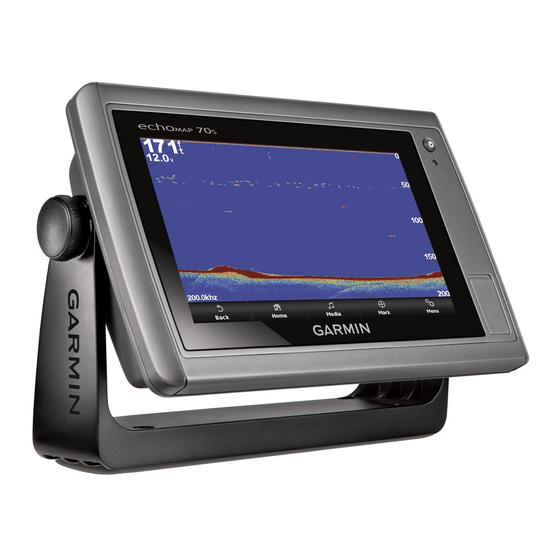Shoreline Distance: Sets how close to the shore you want the
Auto Guidance line to be placed. The Auto Guidance line
may move if you change this setting while navigating. The
available values for this setting are relative, not absolute. To
ensure that the Auto Guidance line is placed the appropriate
distance from shore, you can assess the placement of the
Auto Guidance line using one or more familiar destinations
that require navigation through a narrow waterway
the Distance from
Shore).
Adjusting the Distance from Shore
The Auto Guidance feature is based on electronic chart
information. That data does not ensure obstacle and bottom
clearance. Carefully compare the course to all visual sightings,
and avoid any land, shallow water, or other obstacles that may
be in your path.
NOTE: Auto Guidance is available with premium charts, in
some areas.
The Shoreline Distance setting indicates how close to the shore
you want the Auto Guidance line to be placed. The Auto
Guidance line may move if you change this setting while
navigating. The available values for the Shoreline Distance
setting are relative, not absolute. To ensure the Auto Guidance
line is placed the appropriate distance from shore, you can
assess the placement of the Auto Guidance line using one or
more familiar destinations that require navigation through a
narrow waterway.
1
Dock your vessel or drop the anchor.
2
Select Settings > Navigation > Auto Guidance >
Shoreline Distance > Normal.
3
Select a destination that you have navigated to previously.
4
Select Navigate To > Guide To.
5
Review the placement of the Auto Guidance line, and
determine whether the line safely avoids known obstacles
and the turns enable efficient travel.
6
Select an option:
• If the placement of the Auto Guidance line is satisfactory,
select Menu > Stop Navigation, and proceed to step 10.
• If the Auto Guidance line is too close to known obstacles,
select Settings > Navigation > Auto Guidance >
Shoreline Distance > Far.
• If the turns in the Auto Guidance line are too wide, select
Settings > Navigation > Auto Guidance > Shoreline
Distance > Near.
7
If you selected Near or Far in step 6, review the placement
of the Auto Guidance line, and determine whether the line
safely avoids known obstacles and the turns enable efficient
travel.
Auto Guidance maintains a wide clearance from obstacles in
open water, even if you set the Shoreline Distance setting to
Near or Nearest. As a result, the chartplotter may not
reposition the Auto Guidance line, unless the destination
selected requires navigation through a narrow waterway.
8
Select an option:
• If the placement of the Auto Guidance line is satisfactory,
select Menu > Stop Navigation, and proceed to step 10.
• If the Auto Guidance line is too close to known obstacles,
select Settings > Navigation > Auto Guidance >
Shoreline Distance > Farthest.
• If the turns in the Auto Guidance line are too wide, select
Settings > Navigation > Auto Guidance > Shoreline
Distance > Nearest.
9
If you selected Nearest or Farthest in step 8, review the
placement of the Auto Guidance line, and determine whether
Appendix
(Adjusting
CAUTION
the line safely avoids known obstacles and the turns enable
efficient travel.
Auto Guidance maintains a wide clearance from obstacles in
open water, even if you set the Shoreline Distance setting to
Near or Nearest. As a result, the chartplotter may not
reposition the Auto Guidance line, unless the destination
selected requires navigation through a narrow waterway.
10
Repeat steps 3 through 9 at least once more, using a
different destination each time, until you are familiar with the
functionality of the Shoreline Distance setting.
Other Vessel Settings
When your compatible chartplotter is connected to an AIS
device or VHF radio, you can set up how other vessels are
displayed on the chartplotter.
Select Settings > Other Vessels.
AIS: Enables and disables AIS signal reception.
DSC: Enables and disables digital selective calling (DSC).
AIS Alarm: Sets the collision alarm
Collision Alarm
and
Enabling AIS Transmission Test
Restoring the Original Chartplotter Factory
Settings
NOTE: This will delete all settings information you have
entered.
Select Settings > System > System Information > Factory
Settings.
Appendix
Registering Your Device
Help us better support you by completing our online registration
today.
• Go to http://my.garmin.com.
• Keep the original sales receipt, or a photocopy, in a safe
place.
Cleaning the Screen
Cleaners containing ammonia will harm the anti-reflective
coating.
The device is coated with a special anti-reflective coating which
is very sensitive to skin oils, waxes, and abrasive cleaners.
1
Apply an eyeglass lens cleaner specified as safe for anti-
reflective coatings to the cloth.
2
Gently wipe the screen with a soft, clean, lint-free cloth.
Calibrating the Touchscreen
You can calibrate the screen if the screen is not properly
responding to the touches. The chartplotter touchscreen does
not normally require calibration.
1
Select Settings > System > Display > Calibrate
Touchscreen.
2
Follow the on-screen instructions.
Screenshots
You can capture a screenshot of any screen shown on your
chartplotter as a bitmap (.bmp) file. You can transfer the
screenshot to your computer.
Capturing Screenshots
1
Insert a memory card into the card slot.
(Setting the Safe-Zone
NOTICE
Alerts).
33

